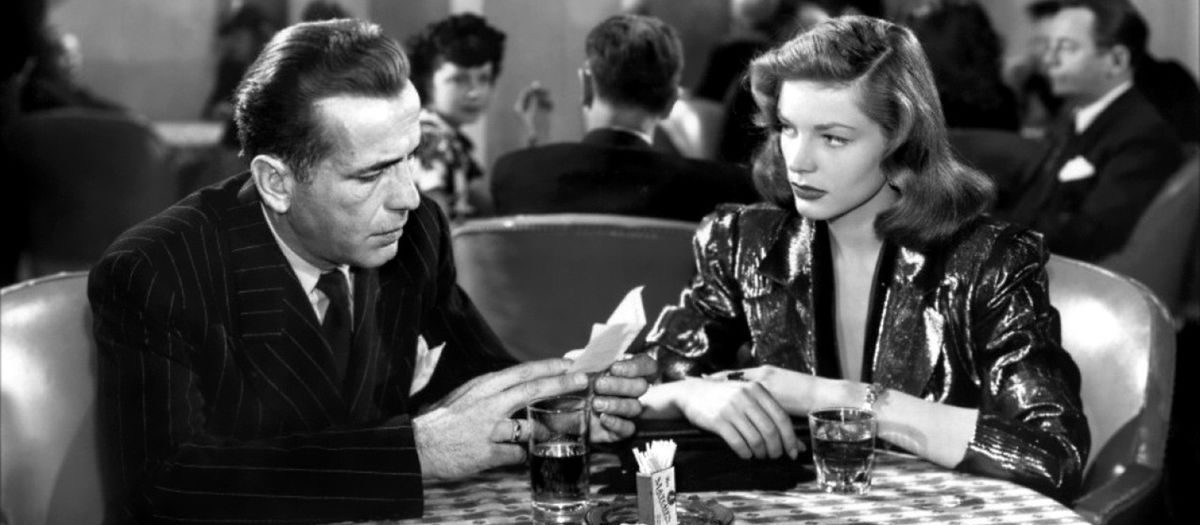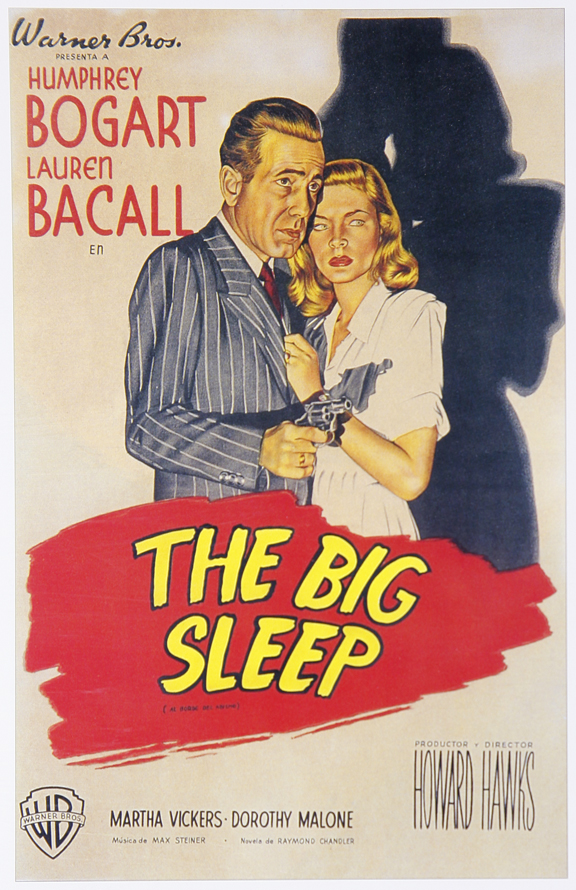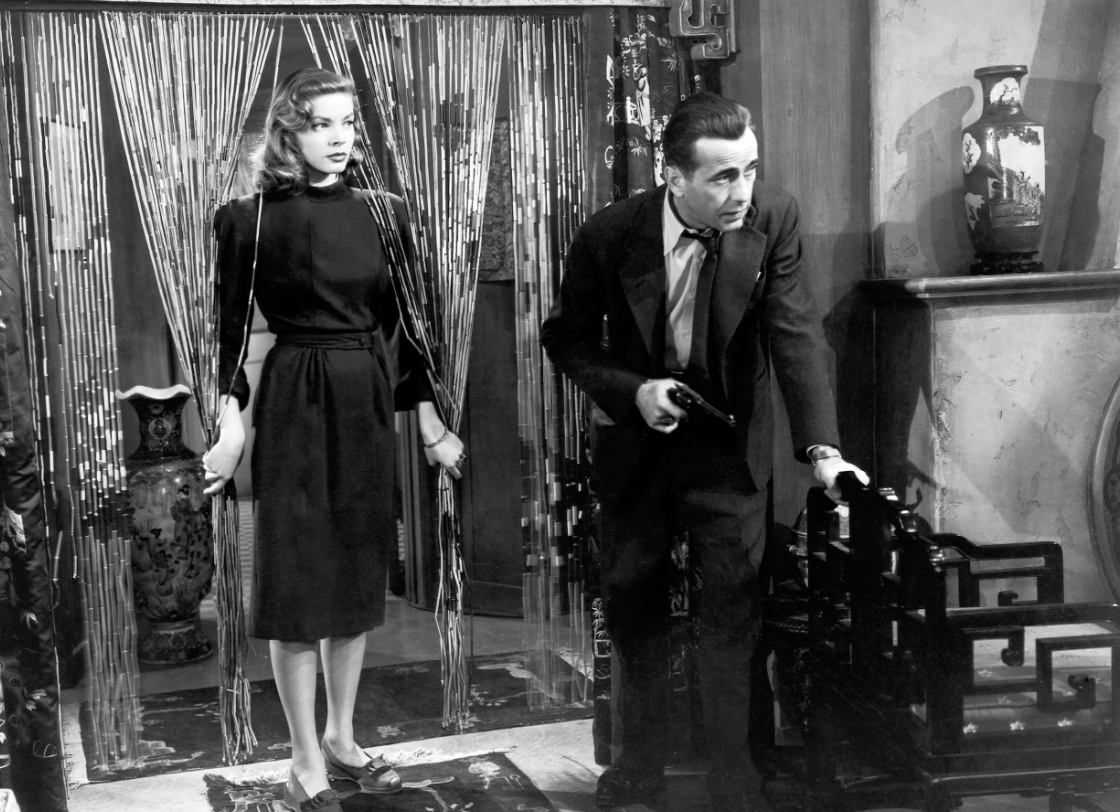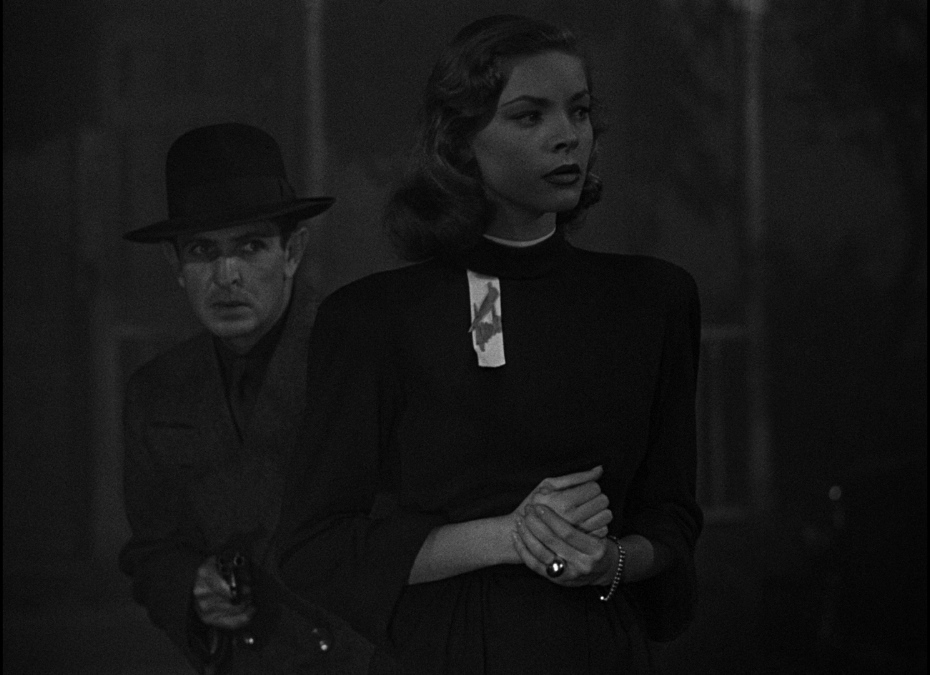

“How do you like your brandy, sir?”
“In a glass.”
The general consensus on The Big Sleep is basically correct. On a scene-by-scene basis, it positively dazzles and goes toe-to-toe with other classic film noirs. But the convoluted source material from Raymond Chandler’s debut novel tends to leave viewers narratively underwhelmed and unsatisfied. Hollywood apocrypha would suggest that at one point during filming, Howard Hawks and Humphrey Bogart called up Chandler to confirm which character shot another one, to which the perpetually soused author replied that he himself didn’t really know! The script—credited to William Faulkner, Leigh Brackett, and Jules Furthman—is a tangled web of names and sub rosa activities that probably requires a whiteboard diagram to figure out, mostly because characters on screen like to rattle off names of characters not present, whom we may or may not have met for a second or two twenty minutes ago. A reshoot/re-edit that beefed up the flirtations between Bogart’s character and Lauren Bacall’s femme fatale to capitalize on their popular pairing in Hawks’ To Have and Have Not excised a decent chunk of exposition, further tipped the film’s balance toward style over substance.

Few would take issue with the film’s premise or presentation. Playful and energetic like Hawks’ screwball comedies, it thrusts Bogart’s Philip Marlowe into a vague missing person’s case that begins when wealthy General Sternwood (Charles Waldron) asks him to resolve “gambling debts” that his nymphet daughter Carmen (Martha Vickers) owes to a shady “bookseller” (Theodore von Eltz). Sternwood used to have a protégé, Sean Regan, who would handle such matters, but he skipped town last month without a word. Sternwood’s other daughter, Vivian (Lauren Bacall), suspects that Marlowe’s actually been hired to track down Regan. Indeed, once the bookseller turns up dead in his own abode after an orgy-gone-wrong, with the younger Sternwood sister drug-addled and giggling over his corpse—after which Sternwood has Marlowe paid for his services and dismissed—a personal interest in the case—not to mention a personal interest in the elder sister’s affections—compels the snarky gumshoe to continue following his nose. As the bodies continue to pile up, he’ll tangle with blackmailers (Louis Jean Heydt), mobsters (John Ridgely), enforcers (Bob Steele), butlers (Charles D. Brown), inspectors (Regis Toomey), and numerous side players of ambiguous allegiance (Sonia Darin, Tommy Rafferty), all of whom are mixed up with the Sternwood family in one way or another. It’s such a build up of red herrings and twists upon twists that even seasoned viewers struggle to connect all the dots. To wit, there’s a late appearance by Elisha Cook Jr.—a recognizable actor with a prominent role The Maltese Falcon—as a patsy of uncertain loyalty who is unceremoniously dispatched after five minutes of screen time. And yet, however brief his appearance, his character is crucial to the plot.
It’s all so terrifically engrossing moment by moment, like a greatest hits album where each song is a winner even if the whole record doesn’t flow particularly well. The studio sets that comprise this Hollywood version of Los Angeles are foggy, smoky, and shadowy, crawling with lowlifes, addicts, voyeurs, deviants, gangsters, gunsels, and sirens, concealing hidden cameras, sidearms, fists, drugs, and poison. Even upper class socialites prove willing to play dirty if it means getting the upper hand. Against this backdrop Hawks arranges Marlowe in scenes ripe with repartee and sexual undercurrents—little eddies of warmth that overwhelm the whirlpool of dark waters.

Indeed, the shamus seemingly cannot go anywhere without having to verbally spar with chatty henchmen (Ben Welden, Tom Fadden) or flirt with another temptress, remaining cool, calm, and collected at all times. About a minute after meeting Dorothy Malone’s bookstore proprietress, it starts raining outside and he comments that he’d “rather get wet in here.” He takes only a few seconds to win the affections of a taxi driver (Joy Barlow) that he asks to tail another car. Of course, those interactions lack the steam that Martha Vickers brings to the screen (in Marlowe’s own words, she tries to “sit on his lap while he’s standing up”), let alone the chemistry between Bogart and Bacall, who had gotten married between the original shoot and the reshoot (nothing says “meant to be” like divorcing your third wife for a fourth)! A 911 call that the pair transforms into a crank call is a particular delight. Throughout, Hawks’ camera is fluid yet unobtrusive, often keeping narratively trivial scenes humming along on sheer showmanship.
The film is so compelling in its nooks and crannies that eventually one must question if Hawks’ decision to overlook his screenplay’s shortcomings in favor of atmosphere, character, and dialogue was not a brilliant stroke. Might a more cohesive story and the intellectual satisfaction of a tidy narrative have distracted from the pleasures of ambience, personality, and star power? It’s a question whose answer lies in the original cut of the film, finally screen publicly in 1997, which increases the story’s clarity with a mid-film recap but slightly dulls its gleam.